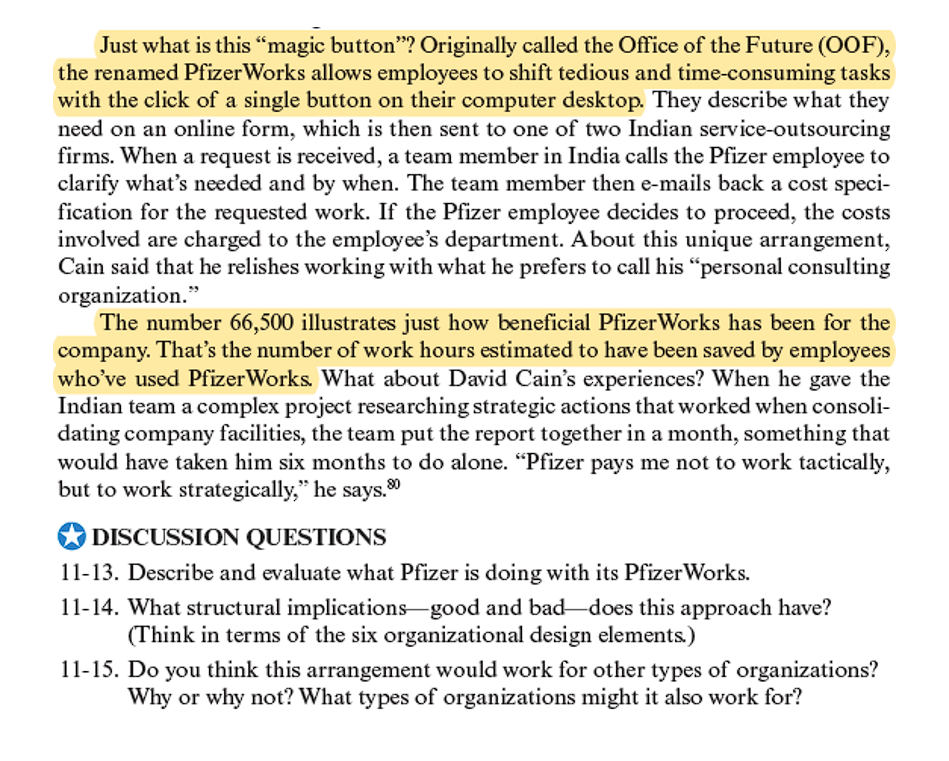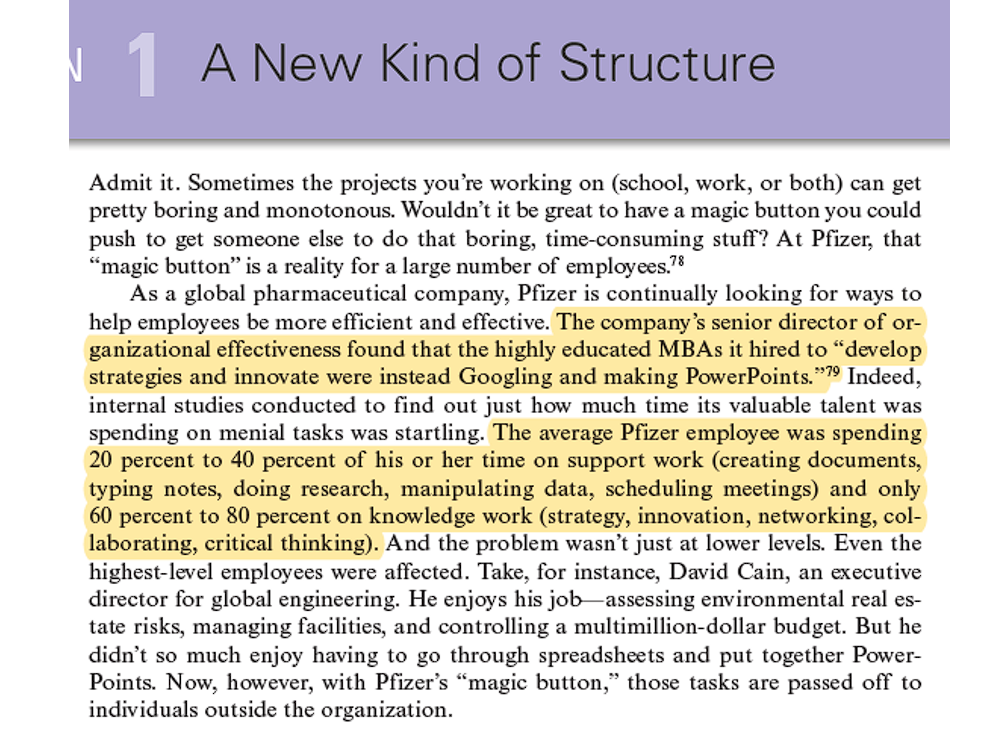Just what is this "magic button"? Originally called the Office of the Future (OOF), the renamed Pfizer Works allows employees to shift tedious and time-consuming tasks with the click of a single button on their computer desktop. They describe what they need on an online form, which is then sent to one of two Indian service-outsourcing firms. When a request is received, a team member in India calls the Pfizer employee to clarify what's needed and by when. The team member then e-mails back a cost speci- fication for the requested work. If the Pfizer employee decides to proceed, the costs involved are charged to the employee's department. About this unique arrangement, Cain said that he relishes working with what he prefers to call his "personal consulting organization." The number 66,500 illustrates just how beneficial Pfizer Works has been for the company. That's the number of work hours estimated to have been saved by employees who've used Pfizer Works. What about David Cain's experiences? When he gave the Indian team a complex project researching strategic actions that worked when consoli- dating company facilities, the team put the report together in a month, something that would have taken him six months to do alone. "Pfizer pays me not to work tactically, but to work strategically," he says.⁹0 DISCUSSION QUESTIONS 11-13. Describe and evaluate what Pfizer is doing with its Pfizer Works. 11-14. What structural implications good and bad-does this approach have? (Think in terms of the six organizational design elements.) 11-15. Do you think this arrangement would work for other types of organizations? Why or why not? What types of organizations might it also work for?
Just what is this "magic button"? Originally called the Office of the Future (OOF), the renamed Pfizer Works allows employees to shift tedious and time-consuming tasks with the click of a single button on their computer desktop. They describe what they need on an online form, which is then sent to one of two Indian service-outsourcing firms. When a request is received, a team member in India calls the Pfizer employee to clarify what's needed and by when. The team member then e-mails back a cost speci- fication for the requested work. If the Pfizer employee decides to proceed, the costs involved are charged to the employee's department. About this unique arrangement, Cain said that he relishes working with what he prefers to call his "personal consulting organization." The number 66,500 illustrates just how beneficial Pfizer Works has been for the company. That's the number of work hours estimated to have been saved by employees who've used Pfizer Works. What about David Cain's experiences? When he gave the Indian team a complex project researching strategic actions that worked when consoli- dating company facilities, the team put the report together in a month, something that would have taken him six months to do alone. "Pfizer pays me not to work tactically, but to work strategically," he says.⁹0 DISCUSSION QUESTIONS 11-13. Describe and evaluate what Pfizer is doing with its Pfizer Works. 11-14. What structural implications good and bad-does this approach have? (Think in terms of the six organizational design elements.) 11-15. Do you think this arrangement would work for other types of organizations? Why or why not? What types of organizations might it also work for?
Chapter1: Taking Risks And Making Profits Within The Dynamic Business Environment
Section: Chapter Questions
Problem 1CE
Related questions
Question

Transcribed Image Text:Just what is this "magic button"? Originally called the Office of the Future (OOF),
the renamed Pfizer Works allows employees to shift tedious and time-consuming tasks
with the click of a single button on their computer desktop. They describe what they
need on an online form, which is then sent to one of two Indian service-outsourcing
firms. When a request is received, a team member in India calls the Pfizer employee to
clarify what's needed and by when. The team member then e-mails back a cost speci-
fication for the requested work. If the Pfizer employee decides to proceed, the costs
involved are charged to the employee's department. About this unique arrangement,
Cain said that he relishes working with what he prefers to call his "personal consulting
organization."
The number 66,500 illustrates just how beneficial PfizerWorks has been for the
company. That's the number of work hours estimated to have been saved by employees
who've used PfizerWorks. What about David Cain's experiences? When he gave the
Indian team a complex project researching strategic actions that worked when consoli-
dating company facilities, the team put the report together in a month, something that
would have taken him six months to do alone. "Pfizer pays me not to work tactically,
but to work strategically," he says.
DISCUSSION QUESTIONS
11-13. Describe and evaluate what Pfizer is doing with its Pfizer Works.
11-14. What structural implications-good and bad does this approach have?
(Think in terms of the six organizational design elements.)
11-15. Do you think this arrangement would work for other types of organizations?
Why or why not? What types of organizations might it also work for?

Transcribed Image Text:N 1 A New Kind of Structure
Admit it. Sometimes the projects you're working on (school, work, or both) can get
pretty boring and monotonous. Wouldn't it be great to have a magic button you could
push to get someone else to do that boring, time-consuming stuff? At Pfizer, that
"magic button" is a reality for a large number of employees.78
As a global pharmaceutical company, Pfizer is continually looking for ways to
help employees be more efficient and effective. The company's senior director of or-
ganizational effectiveness found that the highly educated MBAs it hired to "develop
strategies and innovate were instead Googling and making PowerPoints."7⁹ Indeed,
internal studies conducted to find out just how much time its valuable talent was
spending on menial tasks was startling. The average Pfizer employee was spending
20 percent to 40 percent of his or her time on support work (creating documents,
typing notes, doing research, manipulating data, scheduling meetings) and only
60 percent to 80 percent on knowledge work (strategy, innovation, networking, col-
laborating, critical thinking). And the problem wasn't just at lower levels. Even the
highest-level employees were affected. Take, for instance, David Cain, an executive
director for global engineering. He enjoys his job assessing environmental real es-
tate risks, managing facilities, and controlling a multimillion-dollar budget. But he
didn't so much enjoy having to go through spreadsheets and put together Power-
Points. Now, however, with Pfizer's "magic button," those tasks are passed off to
individuals outside the organization.
Expert Solution
This question has been solved!
Explore an expertly crafted, step-by-step solution for a thorough understanding of key concepts.
This is a popular solution!
Trending now
This is a popular solution!
Step by step
Solved in 5 steps

Recommended textbooks for you

Understanding Business
Management
ISBN:
9781259929434
Author:
William Nickels
Publisher:
McGraw-Hill Education

Management (14th Edition)
Management
ISBN:
9780134527604
Author:
Stephen P. Robbins, Mary A. Coulter
Publisher:
PEARSON

Spreadsheet Modeling & Decision Analysis: A Pract…
Management
ISBN:
9781305947412
Author:
Cliff Ragsdale
Publisher:
Cengage Learning

Understanding Business
Management
ISBN:
9781259929434
Author:
William Nickels
Publisher:
McGraw-Hill Education

Management (14th Edition)
Management
ISBN:
9780134527604
Author:
Stephen P. Robbins, Mary A. Coulter
Publisher:
PEARSON

Spreadsheet Modeling & Decision Analysis: A Pract…
Management
ISBN:
9781305947412
Author:
Cliff Ragsdale
Publisher:
Cengage Learning

Management Information Systems: Managing The Digi…
Management
ISBN:
9780135191798
Author:
Kenneth C. Laudon, Jane P. Laudon
Publisher:
PEARSON

Business Essentials (12th Edition) (What's New in…
Management
ISBN:
9780134728391
Author:
Ronald J. Ebert, Ricky W. Griffin
Publisher:
PEARSON

Fundamentals of Management (10th Edition)
Management
ISBN:
9780134237473
Author:
Stephen P. Robbins, Mary A. Coulter, David A. De Cenzo
Publisher:
PEARSON